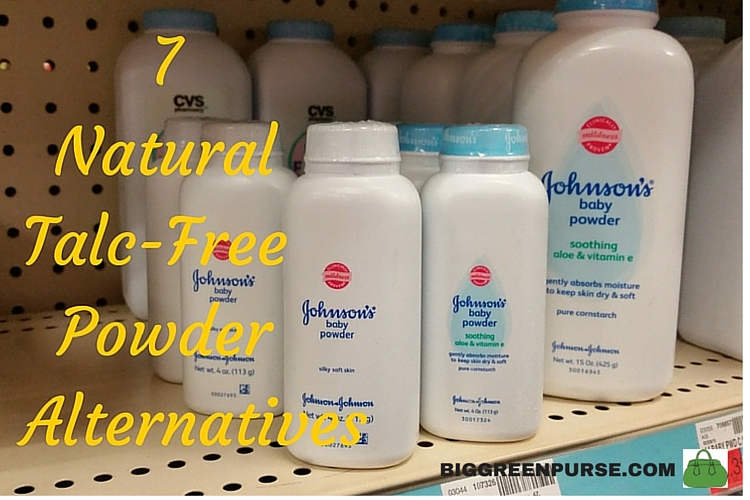
Are you looking for all natural, talc-free powder alternatives?
If you’ve heard about the woman who died from ovarian cancer that may have been caused by her using talc, you may be wondering what you can use instead.
I pulled together this list of safe and healthy options for you.
How Did The Woman Die?
Talc is one of the softest minerals on earth. It’s made up of magnesium, silicon, oxygen, and hydrogen. It has been used for decades in cosmetics and baby products, as well as in items like chewing gum and aspirin.
People like using talc-based powders because they help manage sweat and odors without the pore-clogging chemicals found in stick and roll on deodorants.
However, because they are so fine, they can be dangerous to use.
Jackie Fox, an Alabama woman, died of ovarian cancer allegedly caused by using Johnson & Johnson Shower to Shower powder, baby powder and various feminine products that contain talc. Her family sued J&J and won a $72 million judgement against the company.*
This is a tragedy that shouldn’t have happened. It certainly doesn’t have to happen to you!
Why Choose Talc-free?

Sixteen subsequent case studies over the last thirty years have suggested the same connection, though some more recent studies have cast doubt on those conclusions.
You can read the American Cancer Society’s reviews here.
The overall concern is that, when talc or talc-based products are used on sanitary pads or near the vaginal area, it is easy for fine talc particles to enter the vagina and travel into the reproductive organs.
The first person to make a claim against Johnson & Johnson was Deane Berg. After thirty years of using the company’s “Shower to Shower” product as part of her daily hygiene routine, she was diagnosed with ovarian cancer. She sued the company, but lost.
Right now, dozens of other women are approaching the company with similar complaints. The lawsuit involving Jackie Fox is the first to successfully sue Johnson & Johnson for damages.
Powder by its nature is so fine, it can easily be inhaled or, if you use it around your genitals, absorbed into your body.
Personally, I never powdered my babies. I didn’t want them inhaling the fine particles, and besides, they didn’t really need it. I used ointment to protect them from diaper rash and didn’t bother powdering them after a bath. They smelled good enough!
But if you do want to use powder on yourself, here are some recommendations to use it safely:
• Don’t inhale it. Dab it on rather than dust it wildly. Don’t breathe in while it’s still in the air. Either turn your head away, cover your mouth and nose with a kerchief, or dab it on, then walk away from the powder cloud you send up when you use it.
• Don’t apply it to your genital area. As we saw with previous victims, the fine particles can get into your vaginal tract and cause problems.
• If you use it on your feet, cover your mouth and nose when you’re applying it so you don’t inhale it. Just grab a hand towel or wash cloth and hold them over your mouth and nose while you’re shaking the powder up.
Stand up as soon as you’ve sprinkled the powder so you won’t inhale it.
All Natural, Talc-Free Powder Alternatives
People like using talc because it leaves a smooth and soft feeling on your skin. But products besides talc can offer the same benefit.
Here are a few natural, talc-free powder alternatives that you can use in place of talc-based products.
Please note again that none of these products should be used in the genital area, even if they’re safer to use than talc.
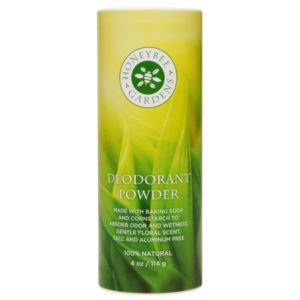
2) DIY Floral Baby Powder – You can make your own baby powder. Chamomile flowers, rose petals, or lavender buds make an excellent alternative when finely powdered and mixed with cornstarch and essential oils.
3) Baking Powder + Cornstarch – When combined and used as a base, these can provide excellent skin protection. To make your own, combine 1/2 cup baking powder and 1/2 cup cornstarch in a jar with a top. Close the jar and shake until well mixed. If you want fragrance, add a drop or two of lavender oil or other oil you prefer, close the jar and shake again.
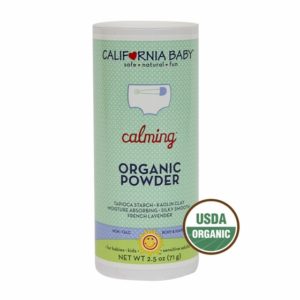
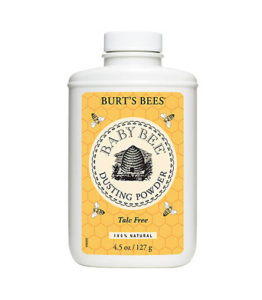
6) Tapioca Starch – Some companies opt to use tapioca as a base because it absorbs oils as well as perspiration. Take a look at Nature’s Baby Organics, which combines tapioca and aloe, and is fragrance-free.
7) Bentonite Clay – This clay can come in different types, but sodium bentonite clay absorbs moisture best. However, calcium bentonite and potassium bentonite can be used as well. You can make your own baby powder by combining bentonite clay with arrowroot powder, chamomile, lavender, calendula, and essential oils. Many natural baby powder companies incorporate bentonite clay into their formulations.
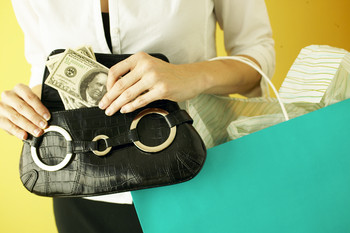
It doesn’t look like talc-based products will be removed from store shelves any time soon. So remember the Big Green Purse motto:
Shift your spending to protect yourself and your family
and tell manufacturers who’s in charge!
When you switch to natural talcum powder alternatives, you’ll send a message to all manufacturers about providing products with healthy ingredients.
*Here’s more information on the J&J lawsuit filed by Jackie Chase’s family.
Many thanks to science writer Megan Nichols for her research and initial draft of this article. Megan enjoys discussing the latest scientific news and discoveries on her blog, Schooled By Science.


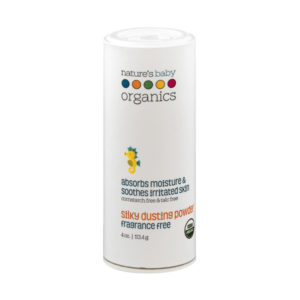









3 thoughts on “7 All Natural Talc-Free Powder Alternatives”
Thanks for this post, because I have been so confused by this talc death, as my grandmother always had a powder puff and talc on her dresser and I have been ‘puffing’ away with talc almost my entire life!
Me too! I used a lot of talcum powder as a little girl, after my bath. But no more!
I’m wondering, can any of these be made into a liquid form that then dries? I had a baby one many years ago (from the dollar store) and it worked great, keeping me fresh all day.
Comments are closed.